Galaxy A02S, A03S, A12 Review: Samsung's Under-$200 Phones Do More Than I Thought
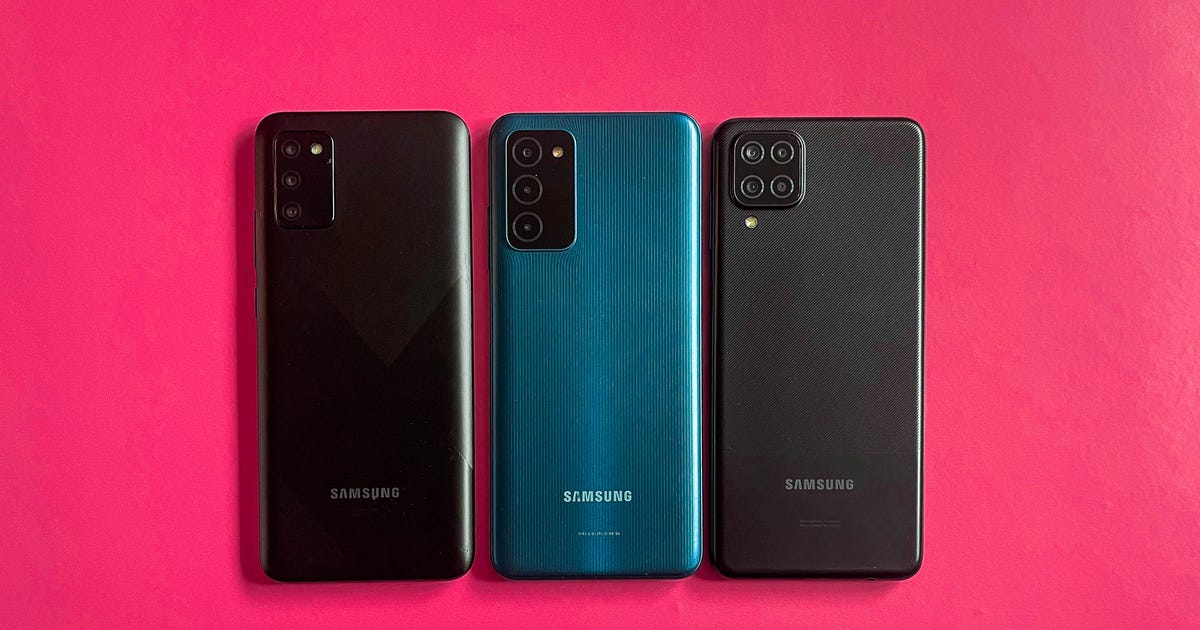
Galaxy A02S, A03S, A12 Review: Samsung's Under-$200 Phones Do More Than I Thought
Samsung's Galaxy S22 and other Galaxy S phones entice buyers with their premium design and features, but those larger screens and multiple cameras do not come cheap. Luckily, Samsung has brought similar features and designs to its Galaxy A series, which includes phones priced as low as $130. Between supply chain constraints and economic hardships brought on by the pandemic, low-cost phones have become particularly important: Even the cheapest phones should allow you to keep up with the news, join video calls, take clear photos and play games.
Samsung's least-expensive phones, which I've been testing for months, can handle basic but necessary tasks. The Galaxy A02S ($130, £139, roughly AU$245), A03S ($160) and A12 ($180) can easily load webpages, stream music, play YouTube videos and take video calls, despite using lower-powered processors than Samsung's midrange and high-end phones. The phones' 6.5-inch screens, capped at 720p resolution, are clear and large enough to run apps and multitask for the most part. But there are some limitations, depending on the device, particularly when it comes to performance and camera quality.
Samsung Galaxy A12, A03S, A02S Specs
| | Galaxy A12 | Galaxy A03S | Galaxy A02S |
|---|---|---|---|
| Display size, resolution, | 6.5-inch LCD, 1,600x720 pixels | 6.5-inch LCD, 1,600x720 pixels | 6.5-inch LCD, 1,600x720 pixels |
| Pixel density | 269 ppi | 269 ppi | 269 ppi |
| Dimensions (Inches) | 6.5 x 2.9 x 0.3 in. | 6.5 x 2.9 x 0.3 in. | 6.5 x 2.9 x 0.3 in. |
| Dimensions (Millimeters) | 165.8 x 75.9 x 9.1 mm | 165.8 x 75.9 x 9.1 mm | 166.5 x 75.9 x 9.2 mm |
| Weight (Ounces, Grams) | 7.12 oz.; 202g | 7.13 oz.; 202g | 6.98 oz.; 198g |
| Mobile software | Android 11 | Android 11 | Android 11 |
| Camera | 16-megapixel (wide), 5-megapixel (ultrawide), 2-megapixel (macro), 2-megapixel (depth) | 13-megapixel (wide), 2-megapixel (depth), 2-megapixel (macro) | 13-megapixel (wide), 2-megapixel (depth), 2-megapixel (macro) |
| Front-facing camera | 8-megapixel | 5-megapixel | 5-megapixel |
| Video capture | FHD (1,920x1,080) at 30fps | FHD (1,920x1,080) at 30fps | FHD (1,920x1,080) at 30fps |
| Storage | 32GB | 32GB | 32GB |
| RAM | 3GB | 3GB | 2GB |
| Expandable storage | Up to 1TB | UP to 1TB | Up to 1TB |
| Battery | 5,000 mAh (charger included) | 5,000 mAh (charger not included, does not support wireless charging) | 5,000 mAh (charger included) |
| Fingerprint sensor | Side | Side | None |
| Connector | USB-C | USB-C | USB-C |
| Headphone jack | Yes | Yes | Yes |
| Price off-contract (USD) | $180 | $160 | $130 |
| Price (GBP) | £169 | £139 | £139 |
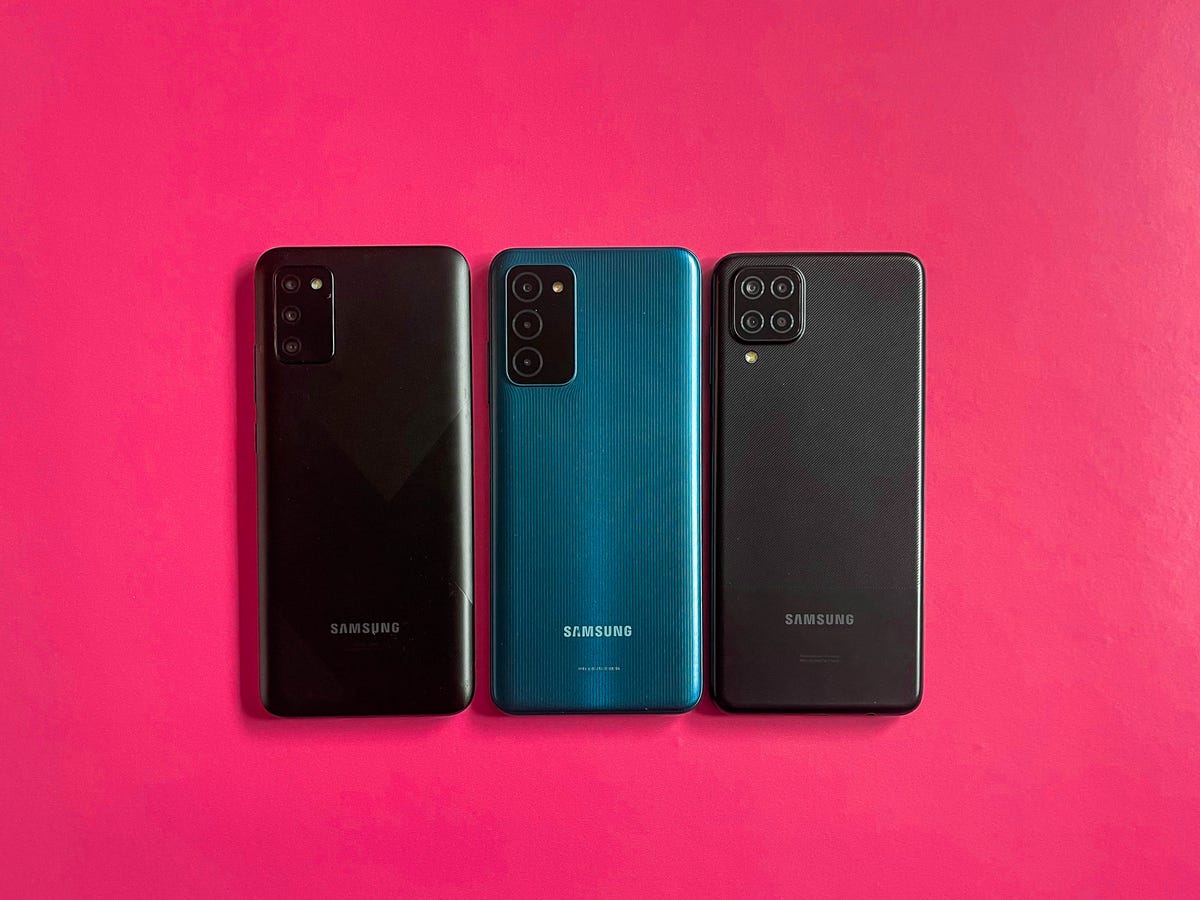
These three Galaxy phones cost $180 or less, and all run on Android 11.
Mike Sorrentino/CNETWhat they all have in common
Other than their screen size, all three phones have some benefits in common. These include battery life, software support and rare features such as headphone jacks and expandable storage.
The 5,000-mAh battery inside each phone easily made it through two days of use, despite having the screen on for upward of four hours a day. That held true even when I spent half the day streaming YouTube videos, listening to podcasts, taking video calls and playing games.
All three phones will receive years of software and security updates, which is particularly important for anyone looking to hold onto a phone for longer than a year or two. Samsung has committed to four years of security updates for these Galaxy A phones, which is a substantial improvement over cheaper phones that previously only received a year or so of support.
Each phone also has a headphone jack, which gives you a simple option for plugging in wired headphones. That's a rare find on modern phones, with headphone jacks getting the ax ever since the iPhone 7 dropped it back in 2016.
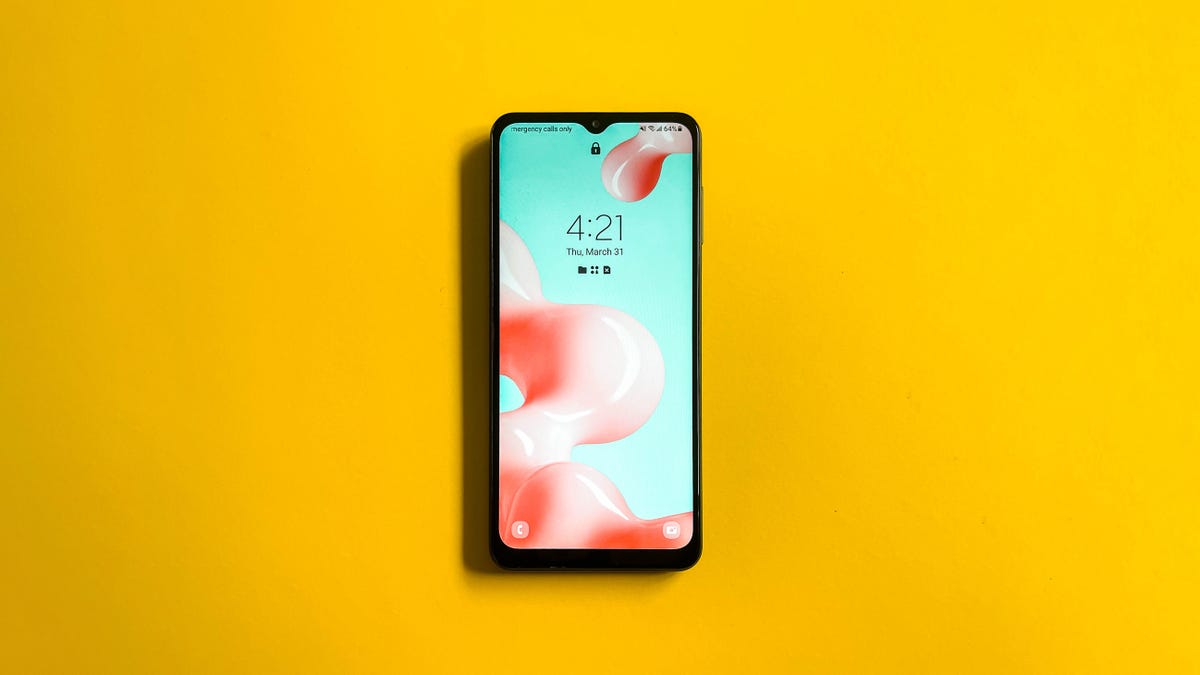
All three phones have a 6.5-inch screen that is capped at 720p resolution.
Mike Sorrentino/CNETHowever, these phones are still all under $200, and compromises certainly had to be made to achieve that low price. The biggest among them is that all three phones only have 32GB of built-in storage. That's basically nothing. By comparison, Apple's new $429 iPhone SE doubles that with 64GB storage, while Samsung's midrange A53 has four times that amount of storage at 128GB. When I began testing the phones, my most recent Android phone backup occupied most of the space. I was left with just enough free space to take about 30 photos until I deleted some apps.
However, all three phones also have a microSD card slot for storage expansion. So you'll want to budget another $20 to $30 for a microSD card if you plan to use these phones to take pictures, download videos or install more apps than the built-in storage can handle.
Other features these phones lack are more understandable at this price range. None of the phones support any version of 5G. They also lack wireless charging. And even though each phone has three or four rear cameras, the image quality ranges from being just OK to downright muddy and blurry. The cameras performed better when snapping outdoor photos of things like buildings and street doughnuts, but struggled when shooting burritos and cocktails in a dim restaurant.

Galaxy A02S photo: A King Cake doughnut taken while outdoors.
Mike Sorrentino/CNET
Galaxy A03S photo of the King Cake doughnut.
Mike Sorrentino/CNET
Galaxy A12 photo of the King Cake doughnut.
Mike Sorrentino/CNETThe big difference is the way these phones juggle multiple tasks. You can indeed buy the cheapest of these phones, the $130 Galaxy A02S, but a few key drawbacks will likely make you want to spend $30 more for the $160 Galaxy A03S. If you decide a slightly better camera is what you want, another $20 gets you the A12 with a fourth lens.
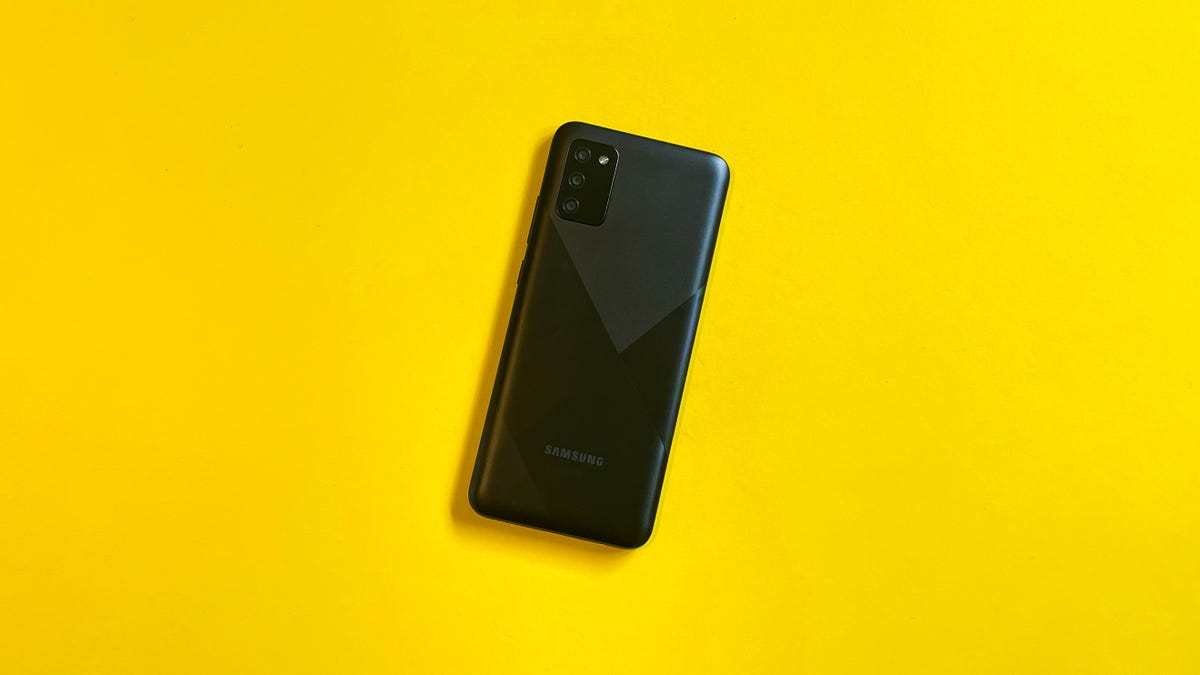
The Galaxy A02S is still available at some US carriers, and it runs Android 11.
Mike Sorrentino/CNETGalaxy A02S: When the lowest price is what matters
When outdoors, the Galaxy A02S is able to put an acceptable amount of detail into its photos, in this case showing snow flurries in a backyard.
Mike Sorrentino/CNETSamsung's Galaxy A02S is the cheapest of the three phones at $130. As you might expect, it also has the fewest frills. There's no fingerprint sensor, so securing your phone will require entering a swipe pattern or PIN code in order to unlock.
But the bigger problem with this phone is that it struggles to handle basic multitasking, likely because it only has 2GB of memory. Playing podcasts and browsing the web works fine, as long as you don't try to do those things at the same time. The music or web browser would crash after just a few minutes of attempted multitasking.
The phone has three cameras on the back, including a 13-megapixel wide main camera, a 2-megapixel macro lens and a 2-megapixel depth camera. A 5-megapixel front-facing camera sits on the front.
Despite having three lenses, the Galaxy A02S' photos lack clarity and crisp colors. It doesn't mean they are unusable. But the Galaxy A02S consistently captured the least detail when compared against the other two phones.
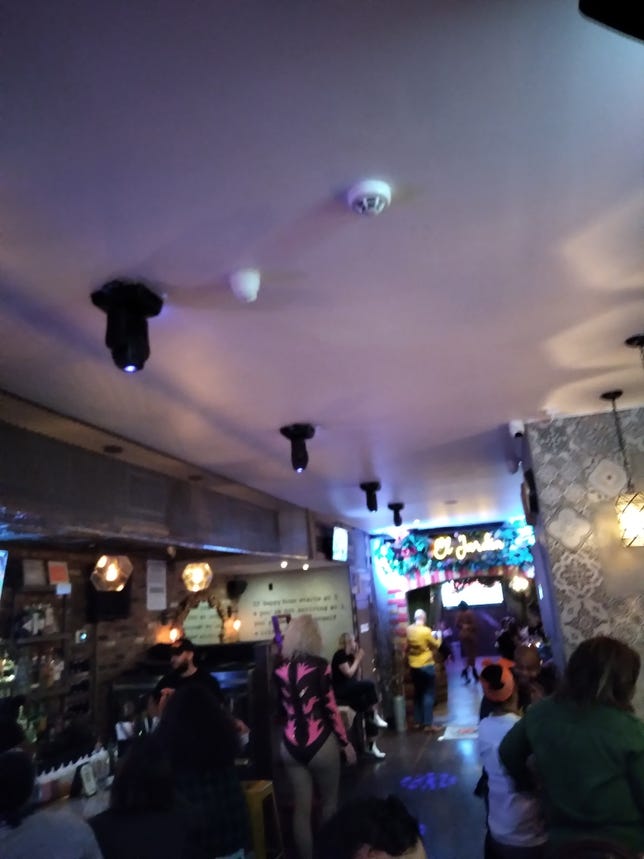
Using the Galaxy A02S to attempt to photograph a drag show inside of a dim restaurant, however, led to a very fuzzy photo.
Mike Sorrentino/CNETFront-facing camera shots were identical across the A02S, A03S and A12, with detail being adequate for group chats. But they weren't impressive enough to make me feel great about selfies, unless the photos were taken outdoors with sunlight.
To its credit, Samsung is actively patching this phone. I received a few updates over the course of my review from November 2021 onward. Some of these issues may be solved by updates, but there are no guarantees.
Unless you absolutely need the cheapest Samsung Galaxy phone possible, paying more will likely get you a phone that suits you better.
Samsung appears to have discontinued the A02S, but you can still buy it from US carriers.
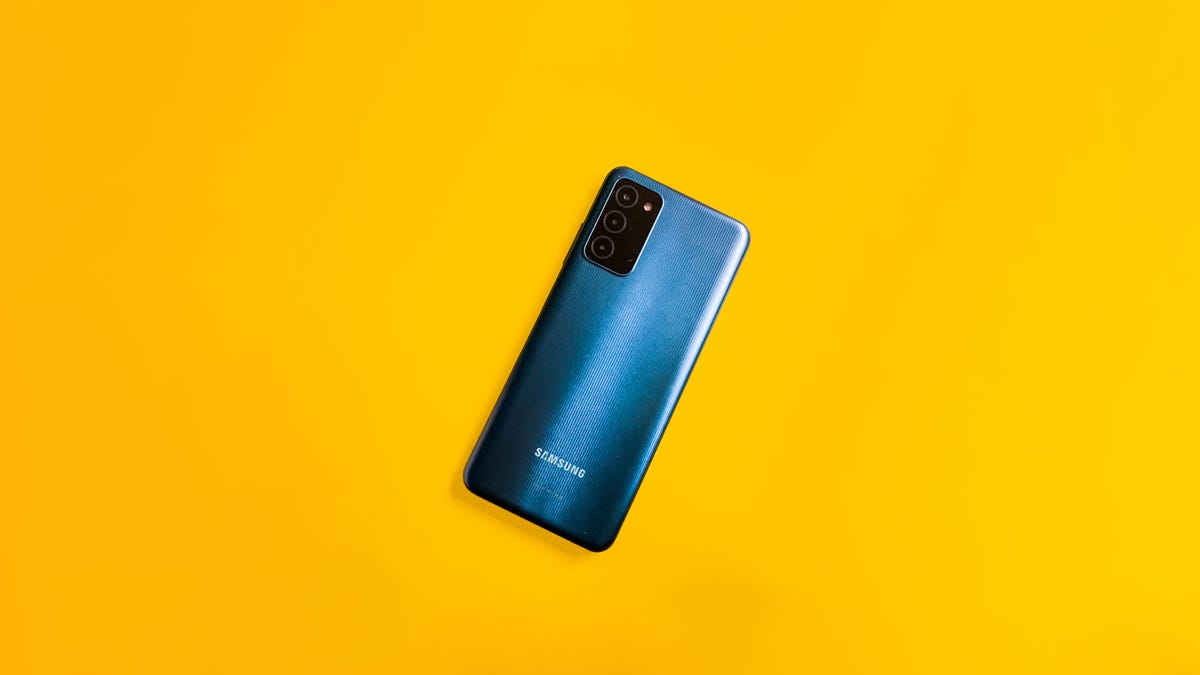
The Galaxy A03S comes in this blue color or a black option.
Mike Sorrentino/CNETGalaxy A03S is Samsung's newest cheaper phone
Samsung's Galaxy A03S is replacing the A02S, but with a $30 price increase to $160. That $30 is very well-spent in my opinion, adding a fingerprint sensor and increasing the memory to 3GB of RAM. Both of these upgrades make the A03S substantially easier to use. The phone also comes in black and blue colors.
The Galaxy A03S' fingerprint sensor is integrated with its power button, which is located on the device's right side. This sensor alone is a substantial improvement, making it so much easier to unlock the phone quickly and securely. You can also perform certain actions using the fingerprint sensor, such as pulling down the notification shade.
The 3GB of memory also appears to solve my chief complaint about the A02S. Multitasking is so much better, and I was even able to play Among Us while on a video call. There is some noticeable lag when entering and exiting apps, but most tasks were otherwise just fine.
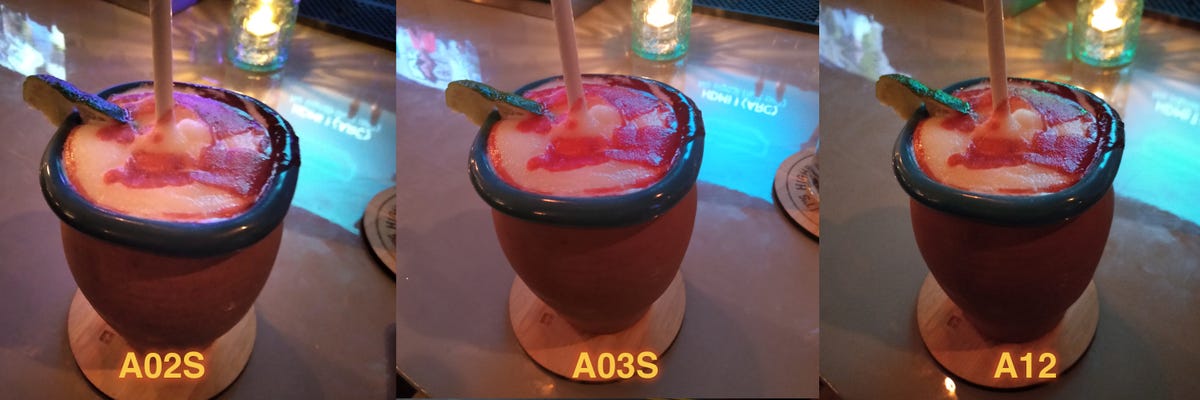
An indoor photo of a restaurant's cocktail taken on the Galaxy A02S, Galaxy A03S and Galaxy A12.
Mike Sorrentino/CNETThe A03S's cameras are still among its weaker points. The hardware is the same as the A02S', which consists of a 13-megapixel main camera, 2-megapixel depth camera and 2-megapixel macro camera. Resulting photos looked clearer to me, with some of my indoor shots looking brighter. It would pass muster for a photo I would post into a group chat, but I probably wouldn't get them printed for framing. Along the front is the same 5-megapixel camera as the A02S.
This phone just launched in January, making it a great option for getting as much as possible of the four years of security update support that Samsung is pledging for its Galaxy phones.

The Galaxy A12 has the best camera of the three phones.
Richard Peterson/CNETGalaxy A12's value is in that fourth camera
Samsung's $180 Galaxy A12 is $20 more expensive than the A03S. Its improvements over the A03S include a better main camera and a fourth ultrawide camera, which should make for clearer photos.
The A12 has a 16-megapixel main camera, a 5-megapixel ultrawide camera, a 2-megapixel macro camera and a 2-megapixel depth camera. I was able to take noticeably better photos with it than I did with the A02S and the A03S. The 8-megapixel front-facing camera is also an improvement.
I noticed more detail in my outdoor shots. You can see the outline of the bricks, for example, on the wall of the church in my photos below.
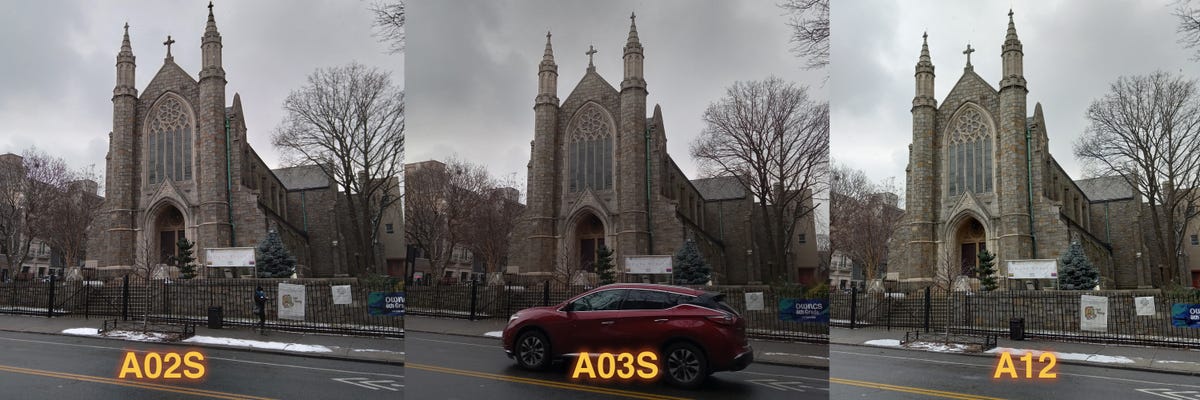
The same outdoor location shot on the Galaxy A02S, the Galaxy A03S and the Galaxy A12.
Mike Sorrentino/CNETHere are some photos I asked a friend to take while I sat on a park swing inside a restaurant. The A12's camera correctly captured the darker location, as well as the glowing sign behind me, without the noise that was noticeable with the A02S and A03S.

On a swing at Fresco's Grand Cantina in Astoria. On the Galaxy A12, the phone's 16-megapixel main camera helps brighten the indoor detail in comparison to the A02S and the A03S phones.
Mike Sorrentino/CNET
The Galaxy A03S was able to brighten the indoor photo, but some of the details are a little bit washed out compared to the A12.
Mike Sorrentino/CNET
The Galaxy A02S appeared to struggle with the dimmer lighting inside of the restaurant, producing a darker image compared to the A03S and the A12.
Mike Sorrentino/CNETLike the A03S, this phone also includes 3GB of memory. It can support many of the same multitasking demands as the AO3S, including gaming while on a video call. Yet there was still apparent lag with some apps, including a delay when shifting between horizontal and vertical screen orientations.
This phone option is ideal for those who want a slightly better camera. But again, you'll want to buy a microSD card since it only comes with 32GB of storage.
There's also a newer version of this phone called the Galaxy A13, which I haven't tested yet. It first launched last year for $249 with 5G, and a $190 4G version just launched this month. That phone also includes four cameras, but bumps the main camera up to 50 megapixels instead of 16 megapixels. The ultrawide camera on that model is 5 megapixels, the depth camera is 2 megapixels along with a 2-megapixel macro camera. But this 4G version also only includes 32GB of storage space, while the 5G version ups storage to 64GB.

The Galaxy A03S offers a good balance of lower cost with decent performance. But get a microSD card if you want it to handle more.
Mike Sorrentino/CNETWhich phone should you buy?
I'd recommend the Galaxy A03S to anyone who wants to spend less than $200 on a new Samsung phone. Since it's the newest of the three phones, it'll get more years of software and security updates. I also found that it offered respectable performance for the price. While the A12 does take better photos, I didn't think the step up in quality was worth the extra $20. Instead, buy the A03S and invest that $20 toward the microSD card you'll need.
If you wanted to check out other sub-$200 phones that aren't made by Samsung, Motorola has the $160 Moto G Pure phone and a $200 Moto G Power phone. The OnePlus Nord N200 5G goes slightly above the $200 threshold at $240, but it offers 5G connectivity.
GEEKBENCH V.5.0 SINGLE-CORE
Note:
Longer bars indicate better performanceGEEKBENCH V.5.0 MULTICORE
Note:
Longer bars indicate better performanceSource
